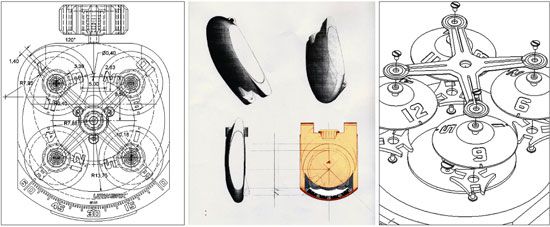
This rather spectacular announcement must not be seen as some sort of ‘marketing’ gimmick to increase the rarity of this line of timepieces. No, not at all. Félix Baumgartner and Martin Frei, the two thinking heads of URWERK do not think like that. They certainly acted as entrepreneurs when, in 2002 after much hesitation, they decided to put everything they had on the table to launch the UR-103. They had to believe in it and have the courage to believe in it. But the two men are also, and above all, artists—artists in the real sense of the term who are not driven by a ‘career plan’ but rather by their desperate need to be creative.
“On a creative level,” explains Félix Baumgartner, “we worked for seven years with all sorts of mechanical and design possibilities that the UR-103 offered. But now, it has done all it can do. We have pushed it as far as it can go.” Martin Frei adds, “As it entered into its seventh year of existence, the 103 reached its maturity to the fullest. We are not interested in repeating ad infinitum the same thing.” Together, they are quick to affirm, “We are not interested in growing larger and larger, ad infinitum, either. But what does interest us now is to move on to other things, to find new mechanical and design challenges, to surprise and amaze once more, to push the frontiers of our research even farther, and to continue to explore. That is what motivates us.”
A form of respect
This attitude—so rare these days—is basically a form of respect. It is respect for those who, as collectors, watch aficionados, aesthetes, or lovers of design and mechanical objects, have remained loyal to URWERK’s adventure with the UR-103 over the years. By stopping the 103, the brand is indirectly saying that these pieces will remain exceptional forever and historic in their own way and that similar watches will never be found. It also shows respect for the age-old culture of timekeeping on which URWERK has always based its practices while still expressing its creations in a very contemporary and post-modern manner. The brand has realized that for this culture to grow, to follow its path and its evolution, it must unceasingly reinvent and revitalize itself. Watchmaking is an art that must constantly be reborn in order to continue to live.
So, hats off then to URWERK that, as a final tribute to the UR-103, is offering two strongly different watches, which synthesize and sum up the collection’s remarkable journey—a journey born, which was very revolutionary for its time, only to become a classic. And as its creators say, “A classic never dies”.
Before we discover these two ultimate ex-pressions that will put the final wrap on a collection that is ‘pure’ but ‘aggressive’ as well as ‘fluid’ but ‘fierce’, let’s go back seven years and take a look at the major steps in the birth and life of the UR-103.
Geneva – January 10, 2002
“We were sitting around the table. The company’s bank statement was lying in front of us. The balance was CHF 100,000. This is all that we had after five years of very hard work. For five long years, we worked to keep our dream alive, but with only mitigated success. Several times we came close to ending it—orders cancelled the day before delivery, prices of component parts too high. We had the incessant feeling that we were on a figure eight—one day, it would be euphoria, the next, depression. Finally, we found ourselves in a hole. We had the plans for our new watch but not enough money to produce it.”
“We were like players at a poker table. We could risk all our chips and make a last-ditch effort, or we could admit defeat and leave the game. CHF 100,000! That was a lot of money for each of us. Thinking of the future, we needed to step back a little. CHF 100,000. It was also a relatively small sum to re-launch our company. We had to make a decision, then and there. First round of the table. Second round of the table. URWERK was clinically dead. But it was way too stupid. We looked at each other. Third round of the table—it cannot end this way. We would go right to the finish. We believed in it. –‘URWERK is not dead. The UR-103 will live!’ we said.”
And so it lived. Five years before making this crucial decision, on which their whole future depended, Félix Baumgartner and Martin Frei created their first watch, the UR-101. The year was 1997, the date they also founded URWERK. Félix and Martin are two friends, bound together by the same desire to shake up watchmaking both aesthetically and mechanically. They come from two different worlds, yet feel totally complementary.
Félix is the son of a watchmaker. Born in Schaffhausen, his bedroom was next to his father’s workshop. Sometimes the young boy had trouble falling asleep since, on the other side of the wall, his father would struggle with something late into the night. A restorer of ancient timekeepers and clocks, at a very early age, he instilled in his son, his love and passion for these marvellous machines filled with moving wheels.
Martin attended the School of Fine Arts in Lucerne and was passionate about contemporary art, architecture and design. He was also influenced by the pop culture of his epoch—by comic strips and science fiction. Not being from the world of watches, as a total outsider, he brought a fresh and different look to the universe of timekeeping.
Where these two men were alike, however, is in their desire to break with current codes. A master watchmaker working notably in the workshops of Vacheron Constantin, Félix did not see himself “doing the same thing” all his life. He wanted a change. As for Martin, he dreamed of doing something concrete, of applying his inspirations to industrial design. Together, they created URWERK. The first part of the brand name is a play on words between ‘Uhr’, the German word for ‘watch’, and ‘Ur’ the ancient Mesopotamian city where the first examples of writing were found. The second half, ‘Werk’, means ‘movement’ in German.
First steps
Their first watch, the UR-101, already included the basic germs of their aesthetical-technical approach that were so particular. The UR-101 is a round timepiece, with still relatively classic workmanship, but deprived of any hand. The ‘dial’ is like a hatch where the opening of a circular arc appears at the top of the face, between 9 and 3 o’clock. The time is read by a travelling hour hand that appears at 9 o’clock behind a small window that intuitively indicates the minutes by travelling along the arc of the circle, divided into 60 minutes, until it reaches 3 o’clock. At the moment the hour disappears, it is instantaneously replaced at 9 o’clock by the number of the next hour. To drive this mechanism, Félix came up with the idea of two invisible and synchronized satellites, each with six numbers that rotate on themselves thus presenting the right number in the window, all while rotating around the movement in 60 minutes.
In its rather reasonable manner, the UR-101 has one remarkable particularity. Contrary to most young brands, URWERK is not interested in accommodating classic complications—tourbillion, minute repeater, perpetual calendar—in a contemporary way. What interested Félix Baumgartner and Martin Frei, and still interests them, is how to radically transform the way time is read by proposing new ways of understanding it, while still offering immediate and intuitive readability.
The UR-101 was remarkable but - undoubtedly because it was still a compromise between two different approaches of watchmaking art - it never really made it to the shore. The two friends found themselves in a dilemma: should they stop or should they try to further advance their adventure.
One day, Félix Baumgartner’s father made a suggestion, a real intuition that would prove to be decisive. What if the hour reading was moved from the top to the bottom of the watch? A critical point, this became the founding principle of the UR-103.
Basel – April 3, 2003
“So there we were. It was 9 o’clock in the morning and we were standing beside the window of our stand at the AHCI. Well, we thought, either it would work or it wouldn’t. We were cruelly aware of the situation yet we had faith in the UR-103. It was an original complication that displayed the hours using satellites. A three-dimensional work. On the back was a world premiere, the control board. The case was like a sculpture. We knew that we had put the best of ourselves into our creation. The only concession was that the case was in stainless steel. There was simply not enough money left to buy the necessary gold. But the piece was a success. It was beautiful both technically and aesthetically. It was a watch made for informed aficionados, that we knew, and it was, in fact, from this perspective that we created it—for those who appreciate the watchmaking arts. Would they like our piece? At 4 o’clock in the afternoon, we received the first orders. At 28 years old, I suddenly felt like I was King of the world,” reminisces Félix Baumgartner.
The presentation of the UR-103 at the Basel fair in 2003 hit the watch world like a small bombshell. Everyone agreed—aesthetes and technicians, watchmakers and designers, collectors and journalists—that this timekeeper was poles apart from all those around it. It was radically different yet it was wearable. It offered a new way of reading time but in a very readable manner. From a technical point of view, it was a total success. From a design point of view, it was irreproachable. It was innovative and cutting-edge and its equilibrium was superb.
Spatial and temporal sculpture
At first glance, the UR-103 looks like a sculpted block, with a wing-like aerodynamic form and a top crown carved like a Doric column. At the same time severe, slender, and smooth, the case (which brings to mind a Brancusi sculpture as much as a space ship) features a large opening at the bottom. The hours appear in an arc on a conic satellite that glides from right to left along the minute scale. When it disappears, another satellite appears right after it, indicating the following travelling hour.
The basic principle is identical to the UR-101 except that the satellites are not only partially visible but now there are four instead of two. In the form of a cone, each of these satellites is based on the principle of the Maltese Cross and bears three numbers: 1, 5, and 9 on the first satellite; 2, 6, and 10 on the second; 3, 7, and 11 on the third; and 4, 8, and 12 on the fourth satellite. They are supported in the centre and carried by an ultra-light orbital cross, made of titanium and driven by the minute wheel, which ensures the perfect distribution of energy and weight. The system is powered by a manual-winding movement decorated with the Côtes de Genève pattern. Beating at 21,600 vibrations per hour (3 Hz), it has a power reserve of 43 hours. The system’s additional base plate is made of a blackened ARCAP material chosen for its high stability and absence of tension that guarantee high precision. The movement is directly accessible from the back of the watch via an opening secured in place with titanium screws.
A world premiere: the control board
At the back of the watch’s grade 5 titanium case is a world’s first in a wristwatch: a control board. This diagnostic centre of the piece—that informs the wearer of the condition of the machine he is wearing on his wrist—is directly inspired by the remarkable particularity of the ancient marine chronometers. These old instruments indicated a number of functions that were not used every day, so they were put on the back of the chronometers. In the UR-103, the control board shows three indicators under the sapphire crystal: small seconds hand, a 15-minute counter hand, and a power reserve indicator hand.
The wearer can also correct the watch to the nearest second and verify its working precision by using a fourth element situated on the back. Located directly under the small seconds, this fourth element is a correcting screw placed above a finely engraved graduated scale. By turning this fine adjustment screw, it is possible to advance or retard the watch by 30 seconds over a 24-hour period. The stability of this device is assured by a direct coupling with the regulating organ of the movement. An outstanding world’s first.
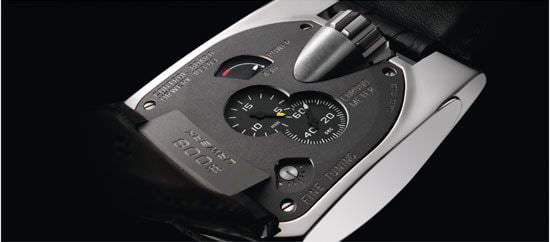
CONTROL BOARD
A new dimension
For its wearer, the UR-103 brings a whole new spatial and poetic dimension to the reading of time, which seems like the sun’s course above the horizon. Intuitively, the wearer visually ‘feels’ the number of minutes that pass and the number that remain. By imagining four conic satellites, Félix Baumgartner offers the possibility to designer Martin Frei of placing the hour numbers on the sides of the satellites. Not only has the size of the numbers been improved but so has their angle of vision. Even when the watch is in a horizontal position, the numbers are re-oriented directly towards the eye of the wearer, meaning that it is no longer necessary to turn the watch to read the time. This held true also for checking the time of the UR-103 when driving with hands on the steering wheel.
Last but not least, the large area, devoid of any indication, above the satellite opening frees up space for placing original adornment. This UR-103 ‘sculpture’ can thus be engraved or decorated at will. Presented at the Basel fair in 2003 and commercially launched the same year, the UR-103 would undergo a series of subtle and radical transformations over the years.
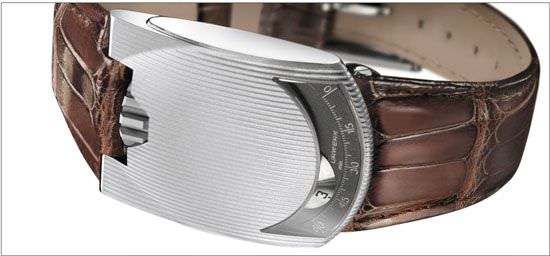
UR-103.01
Gradual unveiling
Since the satellite mechanism is so fascinating, the two creators gradually reveal its secrets. Two years after the UR-103.01 is born, the UR-103.03 comes along in 2005. The upper face of its case opens in the form of a large U to partially reveal the hour satellites. While this opening appears simple enough, it was very complicated to actually create. No sapphire crystal of this size and form has ever been made, thus it was necessary to develop new techniques to craft this transparent ‘canopy’ that would make a large part of the satellite technology be visible.
Martin Frei was at first hesitant to open the crystal since it would go against the brand’s sacrosanct minimalist philosophy, but in the end he was won over to the idea. This would also allow them to create a large space on the face of the watch that would be scratch-resistant. This cockpit-like opening also gave the piece an undeniable mechanical power and strength.
That same year, in 2005, at the invitation of Harry Winston, URWERK demonstrated the height of its talent and inspiration by using the satellite theme in an amazingly whimsical, innovative, and three-dimensional manner. With the very remarkable Opus 5, Félix Baumgartner and Martin Frei played with their own codes, transforming the satellites into dice that rotated on themselves, thereby providing the travelling hour for reading the time.
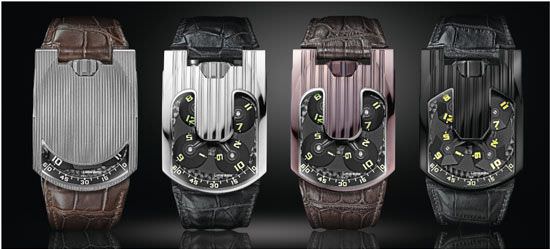
UR-103.01, UR-103.03, UR-103.08 TiAIN, UR-103 HEXAGONE
Aeronautics and jewellery
In 2006, URWERK presents a new model, the UR-103 Blackbird. Like its name implies, this watch—inspired by the stealth jet of the same name—has a black case, made of platinum coated with black PE-CVD (Plasma Enhanced-Chemical Vapour Deposition, more resistant than traditional PVD). Taking the black theme even further, the dial, satellites, and the orbital cross also take on a black PVD coating (the satellites and orbital cross are in grade 5 titanium). The numbers and the minute scale are coated with bright yellow SuperLumiNova that transforms into a rich blue glow at night, reminiscent of the cockpit of a jet. A powerful piece available only in a series of ten watches.
In 2007, the tone of the watches changes radically. With the UR-103.06, URWERK demonstrates the amazing versatility of their ‘creature’. From a stealth jet, the UR-103 turns itself into a superb piece of jewellery. Clearly, the space available for setting diamonds is larger than that offered by a traditional watch. The 103.06 is covered with 277 white diamonds for a total weight of 5.28 carats set into the case, crown and dial. It is available in a limited series of 25 in gold and 10 in platinum.
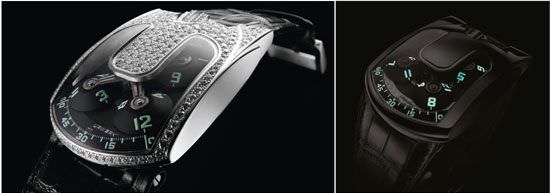
UR-103.06 JOAILLERIE, UR-103 BLACKBIRD
Advanced treatments
URWERK continues its research into materials and their treatments with the UR-103.08 TiAlN. As Martin Frei reminisces from his artistic studies, “In sculpture, the quality of an object comes essentially from the material in which it is sculpted. It’s by working with the material that one feels, from its sensual contact, its interior strength or its softness. It’s by working with it that we can discover its true nature.”
With this idea in mind, URWERK applies a coating to steel that is the hardest and most resistant known today: TiAlN (Titanium Aluminium Nitride). With a thickness of less than 4 microns, the TiAlN coating increases the resistance of the metal to scratches, shocks, oxidation and even acids.
Lighter than equivalent coatings in gold or titanium, the UR-103.08 TiAlN has an intriguing chocolate colour, which ranges between bronze and stormy black depending on the relative proportions of titanium and aluminium in the compound. The difficulty in working with this coating is in finding just the right proportions.
Virile
The year 2008 also sees the creation of a limited series of 10 watches of the new UR-103 Hexagon. The name comes from the form of the satellites that, for the first time, have angular lines, conferring a definite masculine strength to the timekeeper, almost to the point of being aggressive. This virile feeling is strengthened by the totally black PE-CVD coating of the platinum piece. With this model, Félix and Martin also pay homage to one of their earliest pieces, the UR 102, nicknamed the Night Watch, which has since become a collector’s item.
When designing the UR-103 Hexagon, Martin Frei recalls the jet-black India ink that he used during his studies in fine arts. In fact, his first sketches were always drawn in black and white since it was only with the purity of black that an idea reveals its true nature, according to him. He also believes that “black is the supreme colour because it attracts the light, swallows it, and contains all the other colours.”
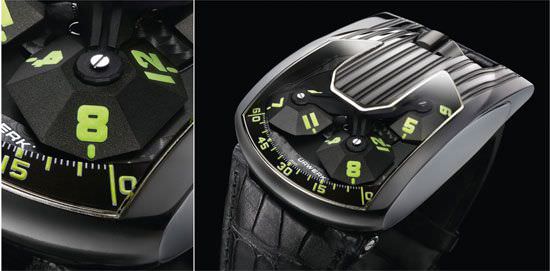
UR-103 HEXAGONE
Venomous
The sign of the ‘T’ dominates the year 2009 at URWERK, with the ‘T’ standing for ‘Tarantula’, the most feared arachnid of its type. In the UR-103T, the entire satellite mechanism and the orbital cross are visible. The cross, however, has been revisited and redesigned for the occasion. Made in ARCAP, a very stable alloy of nickel and copper, the ends of this structure hold the satellites in such a way that the numbers cannot be seen unless they are travelling along the minute scale to tell the time.
To achieve this result, the mechanism for rotating the satellites has been completely modified. They now rotate simultaneously behind their respective hiding places while waiting to enter the long minute scale, thus accomplishing one ‘pirouette’ of 480 degrees in four sequences of 120 degrees. Impressive, powerful, strongly evocative, and nearly venomous, the UR-103T is offered in steel coated with AlTiN (Aluminium, Titanium, Nitride) or in white or pink gold.
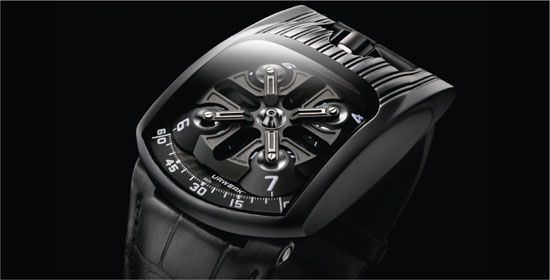
UR-103T TiAIN
The last embers
This year, for its last appearance on the grand watchmaking stage, the UR-103 will present its last embers with a piece that is both more venomous than ever, with the UR-103T ‘Mexican Fireleg Tarantula’, and more transparent than ever, with the UR-103TS ‘Shining T’.
In steel coated with micro-sanded and hand-polished AlTiN and titanium back, the UR-103T ‘Mexican Fireleg’ is directly inspired by the formidable spider of the same name, which has frightening red legs. With its grade 2 titanium orbital cross enhanced with orangey red SuperLumiNova, the same colour and coating that is on the hour numbers and minute markers, the UR-103T Mexican Fireleg will send shivers up the spine of even the most hardened fans of the brand.
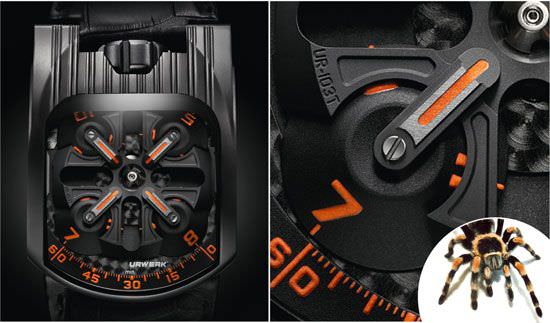
UR-103T ‘MEXICAN FIRELEG’
With ‘S’ standing for ‘sapphire’, the UR-103TS ‘Shining T’ will mark the ultimate unveiling in this line of exceptional timepieces. After having progressively opened the case to reveal the satellite mechanism, URWERK has carved the satellites themselves in blocks of sapphire. The effect is magical, giving the piece a high degree of lightness and a level of transparency never before attained. The mechanism’s fluidity is accentuated even more by the delicate pale blue LumiNova tint of the hour and minute indications.
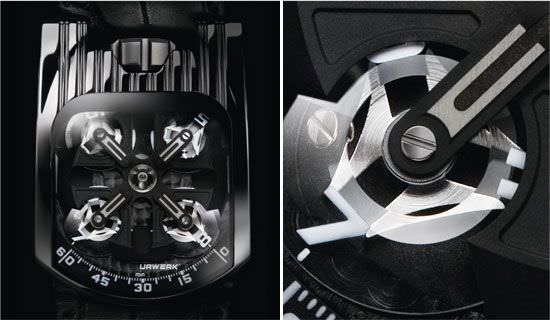
UR-103TS ‘SHINING T’
The saga of the UR-103 thus comes to an end with the ultimate appearance of this last model, a model that is ethereal, nearly celestial.
With this, the UR-103 joins the stars.
Long live URWERK.
Source: Europa Star April - May 2010 Magazine Issue





